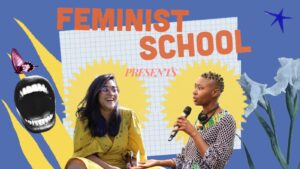“We have our 30 credit Doing Gender module in June once all other MAs are done with teaching. Can you believe it!” said an annoyed peer from the Gender and Development Masters program. “Andrea is going to bring two really established feminist bureaucrats and if she pulls this one off, it will be one of the best learning experiences IDS can offer to its students – it’s a make or break for us,” said another, sounding more optimistic.
Photo: Aditi Bhonagiri, The MA Gender and Development Class of 2015
This was the usual chatter in the corridors at the Institute of Development Studies (IDS) building, at the University of Sussex, in the lead up to the two-week intensive workshop about gender mainstreaming in development institutions that was being planned, albeit shrouded in worrying uncertainty. Some of the uncertainty came from the fact that the convenor of the module, Andrea Cornwall, wanted to experiment with more immersive forms of learning to either enhance or complement conventional classroom style learning that is otherwise staggered over 12 weeks. Aruna Rao and Joanne Sandler from Gender at Work were invited to pilot their Gender Action Learning (GAL) program, specially tailored to prepare MA students specialising in Gender and Development for the world of development work and practice. The rest of us, especially those pursing the overarching Development Studies masters program like myself were really envious of such a promising opportunity. Submitting to part curiosity, part initiative and part coincidence, I decided to audit (attend informally, without credit) the two weeks hoping for it to be a stimulating and insightful learning experience.
The workshop was split in three parts that introduced us to key concepts, themes, strategies and relevant literature on mainstreaming gender in institutions; power dynamics in organisations and systems; feminist leadership and feminist institutionalism; strategic learning and feminist evaluation and monitoring for gender equality. They were also coupled with sessions that allowed us to engage with experiential and creative techniques of learning such as storytelling, forum theatre, simulation exercises and more.
We began by drawing out our own expectations from the workshop: what was interesting about this exercise was that we were not asked to state them in purely transactional terms but carefully situate our responses with reference to how our mind, body and heart felt. This was a clever way to start as it helped everyone gauge where everyone else was positioned in the gender debate — an important dimension that is often assumed i.e. the fact that if we’re advocating for gender equality then we must all be on the same page. This also helped initiate a great safe and interactive space to learn by doing, reflect and share in togetherness. Over the course of the workshop, the creation of a healthy learning community meant that we are all present for each other’s feminist awakenings!
Personally, I found the Gender at Work framework to be an extremely valuable tool to analyse issues of gender inequality not only in organisations but also everyday settings and for my impending dissertation as well. Throughout the course, we were encouraged to use personal case studies to illustrate gendered power dynamics and use the framework to map out points of intervention for change and make visible discriminatory social norms and organisational deep structures of inequalities that were perpetuated, for example, even within the Institute we study at and blindly assume to be gender-aware and gender-responsive.
By looking inwards, we were also able to build consciousness on what role we chose to play in a certain situation and found that we ourselves were often responsible for reproducing discriminatory patriarchal norms and practices that are often deep rooted and resilient. And to truly demonstrate a fantastic learning culture that was created over the few days, we ended our course by applying the tools and strategies we had learnt, to evaluate our own workshop!
Aruna and Joanna’s enthusiasm and expertise is really what made this intensive training period such an enjoyable, memorable and inspiring process. As a student, I definitely feel re-energised and equipped to step into the “real world” of fighting gender inequality and contributing to change at multiple levels. The learning process has only just begun.
by ADITI BHONAGIRI
Gender at Work and the School of Global Studies at the University of Sussex jointly held a course, Doing Gender, in June, at the University of Sussex. Aditi Bhonagiri attended the course.




